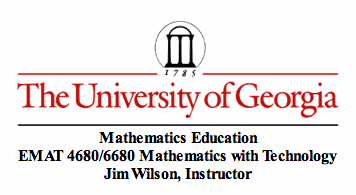

The investigation begins with the following problem.
Given two circles and a point on one of the circles. Construct a circle tangent to the two circles with one point of tangency being the designated point.
We would like to explore the tangent circles in the following situations:
case (i) circle B is inside circle A
case (ii) circle A and B are intersecting
case (iii) circle A and circle B are disjoint
Part 1: Construction of case (i) circle B is inside circle A
1. First, construct two circles with centers A and B, respectively. Construct point Q to be any point on the circle A. 2. Construct a line passing through AQ and a radius BD on circle B.
[side note to Amena to fix before final turn in of assignments: must fix the fact that circle B is tangent to circle A. This is a special case and not the general case.]
3. Construct a circle with center Q and radius BD. Let's call this radius QI of circle Q. 4. Construct a line segment connecting I and B. Find its midpoint F. 5. Construct a line that is perpendicular to BI. Where this line intersects line AQ, call this point K. 6. Construct line segments KI and KB. 7. Now, construct a circle with center K and radius of KQ. 8. As Q moves around circle A, you can see that circle with center K is our tangent circle to circle with center B. Click here for an interactive applet of this construction. Move Q around the circumference of circle A and make a discovery!
Click here to discover the tangent circle in case (ii) circle A and B are intersecting.
Click here to discover the tangent circle in case (iii) circle A and circle B are disjoint.
Exploration: Investigate, discuss, and state conjectures about the loci of the centers of the tangent circles for all cases you construct.
You should consider this for cases (i), (ii), and (iii). Provide justifications.
Exploration, Part 1: When circle B is inside circle A (i.e. case (i))
As in our construction, we see the example of when circle B is inside circle A. What happens when we animated our point Q and trace our point K?
We see that this gives us an ellipse. Let's remind ourselves what an ellipse is. To be an ellipse, the two focii, in our case points A and B, and their distance to K must be a positive constant.
Let's look back at our construction.
In order to prove this is an ellipse, we must show that AK + BK is a positive constant, regardless of the location of C on the circumference of circle A. Since line KF is perpendicular to the midpoint of BE, we see that BK = EK. Also, AE equals radius of circle B and circle A. Therefore:
AE = AK + KE = AK + BK
Then, regardless of the location of point C on circle A, we see that AK + BK is a positive constant. This implies that we have an ellipse with focii A and B.
Exploration, Part 2: When circle B and circle A intersect.
As in part 1 of the exploration, let's trace point G and discover what occurs as C moves along the circumference of A.
We see that an ellipse again appears. Let's try to prove this using our construction.
As in part 1 of the exploration, we have that BG = GE and that AE equals the radius of circle A and circle B.
Therefore:
AE = AG + GE = AG + BG.
So, AG + BG will always be a positive constant regardless of the location of the point on the circumference. It is indeed an ellipse.
Exploration, Part 3: When circle B is outside circle A.
Let's begin by animating point C when circle B is outside circle A.
Looking at the above still of this step, we see that we have something a bit different. Instead of an ellipse, we have a hyperbola. To prove it is indeed a hyperbola, we only need to show that AG + BG is always a positive constant. We should start by looking at our original construction.
So, we know that GB = GE and that GE = GA + AE. This provides the equation GA = GE - AE or GA = GB - AE. Also, AE = AC + CE. So, we can conclude that AG + BG will always be a positive constant regardless of where the point is on the circumference of circle A.
Exploration, Part 4: When circle B is inside of circle A.

Again, we know that DG = AG. Also, BD = BG +DG.
Therefore:
BD = BG + DG = BG + AG.
This again gives us a positive number for AG+BG. So no matter the point on P on circle A, these will remain positive constants. Therefore, A and B are focii of our ellipse.
To summarize we notice that the loci of the center of the two circles form either a hyperbola or an ellipse. When our circle B was not contained inside the tangent circle, then the trace of the center point of the tangent circle formed a hyperbola. When our circle B was contained or intersected our tangent circle, then the trace of the center point of our tangent circle formed an ellipse. In all explorations, we see that A and B are the focii of either an ellipse or a hyperbola.